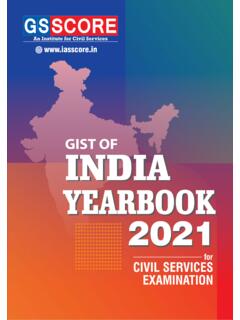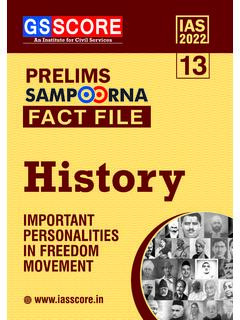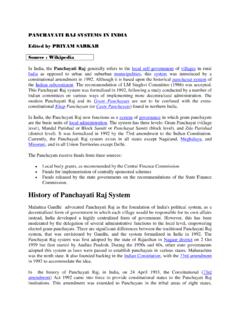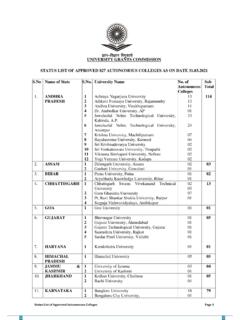Transcription of BEST PRACTICES 4 e-SERVICES
1 BEST PRACTICES : E SERVICES1| |e-ServicesCommon Services Centres (CSC )Common Services Centre (CSC) programme is an initiative of the Ministry of Electronics & IT (MeitY), Government of India. CSCs are the access points for delivery of various electronic services to villages in India, thereby contributing to a digitally and fi nancially inclusive of Common Services Centres (CSCs)Common Service Centre Programme is designed to support the access for digital initiatives of Government for rural India. Lack of infrastructure and service delivery medium was one of the hurdles for the complete digitization of the country. On one hand when the nation is going towards more and more digitization of governance and service delivery. The lack of support system was nullifying the whole objective of governance as still majority of the Indian Population still reside in rural area as most of the e-governance initiatives are lying underutilized.
2 Common Service Centre (CSC) Scheme This is one of the Mission Mode Projects under Digital India programme. Initially the CSC Scheme was approved by the Government of India in September 2006 under NeGP. The scheme aimed for the establishment of one lakhs ICT enabled front-end service delivery outlets, equitably spread across rural India in the ratio of one CSC per six villages, thereby covering all six lakhs villages. CSCs were envisaged as internet enabled centres allowing access of government, private and social services to citizen. The Scheme was implemented on PPP mode Government (DIT, SDA, CSC SPV), Service Centre Agency (SCA) and VLE. SCA was supposed to get Revenue Support (viability gap grant).About Common Services Centres (CSC ) Based on the assessment of CSC scheme, the Government launched the CSC scheme in 2015 to expand the outreach of CSCs to all Gram Panchayats across the country.
3 Under the Digital India programme, at least one CSC (preferably more than one) is envisaged in lakh Gram Panchayats for delivery of various electronic services to citizens across rural India. This would include strengthening and integrating the existing 100,000 CSCs under the CSC scheme and making operational an additional lakh CSCs in Gram PRACTICES : E SERVICES| | It envision the development of CSCs as a reliable and ubiquitous IT-enabled network of citizen service points connecting local population with government departments, business establishments, banks, insurance companies and educational institutions, with an impact on primary, secondary and tertiary sectors of the country s economy. CSC is a service delivery oriented entrepreneurship model with a large bouquet of services made available for the citizens through optimum utilization of infrastructure already created in the form of SWAN, SSDG, e-District, SDC, and NOFN/BharatNet.
4 CSC - Common Service Centres, has been set up by the Ministry of Electronics & IT under the Companies Act, 1956 to oversee implementation of the CSC scheme. Common Service Centres (CSC) scheme provides a centralized collaborative framework for delivery of services to citizens through CSCs, besides ensuring systemic viability and sustainability of the Scheme. Implementing Agency : CSC e-Governance Services India Ltd (CSC SPV)Key Features of CSC scheme A self-sustaining network of lakh CSCs in Gram Panchayats Large bouquet of e-SERVICES through a single delivery platform Standardization of services and capacity building of stakeholders Localised Help Desk support Sustainability of VLEs through maximum commission sharing Encouraging more women as VLEsObjectives of CSC Non-discriminatory access to e-SERVICES for rural citizens by making CSCs complete service delivery centres, utilizing the infrastructure already created in terms of other Mission Mode Projects.
5 Expansion of self-sustaining CSC network till the Gram Panchayat level lakh CSCs, at least one CSC per Gram Panchayat, more than one preferred. Empowering District e-Governance Society (DeGS) under the district administration for implementation. Creating and strengthening the institutional framework for rollout and project management, thereby, supporting the State and District administrative machinery and handholding of VLEs through local language Help Desk support. Enablement and consolidation of online services under single technology platform, thereby making the service delivery at CSCs accountable, transparent, effi cient and traceable, with a technology-driven relationship between all stakeholders. Providing Centralized Technological Platform for delivery of various services in a transparent manner to the citizens. Increasing sustainability of VLEs by sharing maximum commission earned through delivery of e-SERVICES and encouraging women to join as cance of the Scheme Transparent and timely delivery of government and other eServices at aff ordable cost.
6 Reducing citizens eff orts and resources in availing services within their localities by eliminating their visit to Government offi ces for the same. Integrated framework for delivery and dissemination of various government initiatives and benefi ts through ICT enablement. BEST PRACTICES : E SERVICES3| | Introducing change agents for skill development, education and trainings, fi nancial inclusion and indirect employment generation. Acting as last mile distribution units for various governments direct benefi ts to marginalised/backward communities. Encouraging more and more participation of women to become VLEs and increasing their contribution in the social and economic development. The CSCs are acting a medium for rural citizens to get digitally empowered and interact with the government and its So Far CSCs are present across the Country In all the 2 states and 8 UTs. CSCs are providing services through CSC National Portal and Various State Portals.
7 More than 52 Central Government Services are available on CSC National Portal. Apart from, a large number of State Govt Services are also available on CSC National Portal. The number of State Services varies from State to State in the range of 20 170 Forward High time and travel transaction cost , low digital literacy and low awareness are among the key challenges faced by CSCs in rural India. These challenges should be tackled to make the programme more eff ective. Additional camps should also be set up by the government. The PPP model of the CSCs presently lacks a strong grievance redressal mechanism in case of failure in providing a G2C service for any reason. Government should ensure long term sustainability of these centres and an accountability gap should also be fi lled. A strong accountability mechanism ensures a formal route for grievance registration and redress, regular government supervision and monitoring of the centres for enforcement of mandates, transparency through mandatory display of rate-list for all services off ered.
8 Identifying areas specifi c challenges and developing a hierarchical framework of challenges would help decision-makers develop and implement eff ective strategies for delivering integrated e-SERVICES to citizens at CSCs. E-Dakhil Portal This is a web application for E-fi ling of consumer complaints named that has been developed by NIC for the purpose. Need for E-Dakhil Portal Earlier, the complainant had to visit the District Commission and State Commission for fi ling of the complaint. Along with this, they had to manually go to the bank to make a draft to be submitted as court fees and the paperwork was cumbersome. About E-Dakhil Portal E-fi ling was launched by National Consumer Dispute Redressal Commission (NCDRC) on 7th September, 2020. This digital software for fi ling consumer complaints has the many features like e-Notice, case document download link & VC hearing link, fi ling written response by opposite party, fl ing rejoinder by complainant and alerts via PRACTICES : E SERVICES| | The e-daakhil portal empowers the consumer and their advocates to fi le the consumer complaints along with payment of requisite fees online from anywhere for the redressal of their complaints.
9 It also facilitates the consumer commissions to scrutinize the complaints online to accept, reject or forward the complaint to the concerned commission for further processing. To facilitate the rural consumers for e-fi ling, it has been decided to integrate the Common Service Centres (CSC) with the e-daakhil portal. As many consumers at Gram Panchayat level may either not have access to electronic modes of communication or unable to use the tools, they may avail the services of CSCs in fi ling their complaints in the Consumer Commission. The work for integration of this portal with CSC is in under cance of the portal The eDaakhil portal allows consumers to fi le complaints at their convenience, from anywhere, diminishing the requirement of their physical presence at consumer commissions. It also allows for consumer commissions to scrutinise these online submitted complaints and accept, reject or forward these to the concerned commission for further processing.
10 With the enactment of Consumer Protection Act, 2019, which has stated specifi c provisions for fi ling of complaint online, E-Daakhil portal will prove to be a boon to the aggrieved consumers. Now, the court will reach the houses of the complainant in India, where the complainants can avail the portal to pay their fees online through UPI, Internet Banking, Debit Card, etc. Status of its implementation E-fi ling was launched by National Consumer Dispute Redressal Commission (NCDRC) on 7th September, 2020. Delhi was the fi rst state to implement it on 8th September, 2020. Later Maharashtra, Andaman & Nicobar Islands, Bihar, Chhattisgarh, Jharkhand, Gujarat, Chandigarh, Andhra Pradesh, Odisha, Uttar Pradesh, Madhya Pradesh, Punjab, karnataka & Haryana implemented facility of e-fi lling in their respective states /UTs. Department of Consumer Aff airs had been proactively following up with the states /UTs to launch e-fi ling.


















